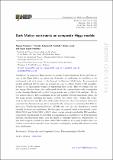| dc.contributor.author | Funchal, Renata Zukanovich | |
| dc.contributor.author | Lessa, Andre | |
| dc.contributor.author | Lopez-Honorez, Laura | |
| dc.contributor.author | Fonseca de Sa, Nayara | |
| dc.date.accessioned | 2015-08-25T20:57:47Z | |
| dc.date.available | 2015-08-25T20:57:47Z | |
| dc.date.issued | 2015-6 | |
| dc.identifier.issn | 1029-8479 | en_US |
| dc.identifier.uri | http://hdl.handle.net/1721.1/98231 | |
| dc.description.abstract | In composite Higgs models the pseudo-Nambu-Goldstone Boson (pNGB) nature of the Higgs field is an interesting alternative for explaining the smallness of the electroweak scale with respect to the beyond the Standard Model scale. In non-minimal models additional pNGB states are present and can be a Dark Matter (DM) candidate, if there is an approximate symmetry suppressing their decay. Here we assume that the low energy effective theory (for scales much below the compositeness scale) corresponds to the Standard Model with a pNGB Higgs doublet and a pNGB DM multiplet. We derive general effective DM Lagrangians for several possible DM representations (under the SM gauge group), including the singlet, doublet and triplet cases. Within this framework we discuss how the DM observables (relic abundance, direct and indirect detection) constrain the dimension-6 operators induced by the strong sector assuming that DM behaves as a Weakly Interacting Particle (WIMP) and that the relic abundance is settled through the freeze-out mechanism. We also apply our general results to two specific cosets: SO(6)/SO(5) and SO(6)/SO(4)×SO(2), which contain a singlet and doublet DM candidate, respectively. In particular we show that if compositeness is a solution to the little hierarchy problem, representations larger than the triplet are strongly disfavored. Furthermore, we find that composite models can have viable DM candidates with much smaller direct detection cross-sections than their non-composite counterparts, making DM detection much more challenging. | |
| dc.description.sponsorship | United States. Dept. of Energy (Grant Contract DE-SC00012567) | |
| dc.description.sponsorship | National Science Foundation (U.S.) (Grant NSF PHY11-25915) | |
| dc.description.sponsorship | Seventh Framework Programme (European Commission) (ITN INVISIBLES Marie Curie Actions PITN-GA-2011-289442) | |
| dc.language.iso | en_US | |
| dc.publisher | Springer-Verlag | |
| dc.relation.isversionof | http://dx.doi.org/10.1007/jhep06(2015)154 | en_US |
| dc.rights | Creative Commons Attribution | en_US |
| dc.rights.uri | http://creativecommons.org/licenses/by/4.0/ | en_US |
| dc.source | Springer-Verlag | en_US |
| dc.title | Dark Matter constraints on composite Higgs models | en_US |
| dc.type | Article | en_US |
| dc.identifier.citation | Fonseca, Nayara, Renata Zukanovich Funchal, Andre Lessa, and Laura Lopez-Honorez. “Dark Matter Constraints on Composite Higgs Models.” J. High Energ. Phys. 2015, no. 6 (June 2015). | en_US |
| dc.contributor.department | Massachusetts Institute of Technology. Center for Theoretical Physics | |
| dc.contributor.mitauthor | Fonseca de Sa, Nayara | |
| dc.relation.journal | Journal of High Energy Physics | en_US |
| dc.eprint.version | Final published version | en_US |
| dc.type.uri | http://purl.org/eprint/type/JournalArticle | en_US |
| eprint.status | http://purl.org/eprint/status/PeerReviewed | en_US |
| dspace.orderedauthors | Fonseca, Nayara; Funchal, Renata Zukanovich; Lessa, Andre; Lopez-Honorez, Laura | en_US |
| mit.license | PUBLISHER_CC | en_US |
| mit.metadata.status | Complete | |
